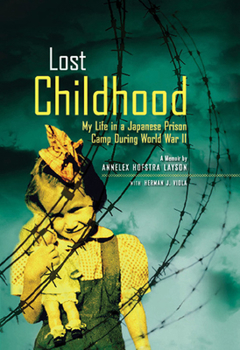Lost Childhood: My Life in a Japanese Prison Camp During World War II
Select Format
Select Condition 
Book Overview
Lost Childhood is the vivid, first-hand account of the horrors of war through the eyes of a child. This real-life memoir breaks a 60-year silence to tell one woman's riveting story of prisoner life during World War II. As a little Dutch girl in Indonesia, Annelex Hofstra's comfortable world was torn apart when she and her family were sent to Japanese prison camps for three and a half years. The story begins in 1942 when four-year-old Annelex is living on the island of Java in the Dutch East Indies (now Indonesia). Her grandfather is a successful planter, and her father is a pilot instructor in the Royal Netherlands Navy. But her carefree childhood ends as the Japanese invade Java, and along with 10,000 other Dutch residents, Annelex's family is rounded up. With few belongings, they are shipped off to interment camps, to a helpless, unknown future. In a shockingly honest narrative, we learn of the tactics used by their captors to dehumanize the Dutch prisoners. We learn of the grinding daily routine of the prisoners, the food rations, the sleeping arrangements, and the awful sanitary conditions. We share in Annelex's near-death bout with malaria. We also share some of the awful things she witnessed--extracting parasitic worms from a fellow-prisoner's throat; the agonizing death by starvation of women punished for stealing food; and the sight of bodies being piled high on a truck. Eventually the hell ends and the family is liberated. But the girl's personal hell plagues her in freedom. Just days after she is reunited with her father, he is killed in an explosion. World war is replaced by civil war in Indonesia, forcing the family to flee first to Holland and then to the U.S., where the family tries to mend their broken lives. For 60 years Annelex Hofstra Layson has repressed her early memories, shielding even her husband and children from the horrors of her past. With Lost Childhood, her harrowing ordeal is finally revealed. The author shares her story now to provide hope in young lives torn apart by war, and to inspire future generations to work for peace.
Format:Hardcover
Language:English
ISBN:1426303211
ISBN13:9781426303210
Release Date:October 2008
Publisher:National Geographic Kids
Length:112 Pages
Weight:0.70 lbs.
Dimensions:0.6" x 5.6" x 8.5"
Age Range:10 to 14 years
Grade Range:Grades 5 to 9
Customer Reviews
1 rating
A harsh topic, but carefully recounted for adolescent readers...
Published by Thriftbooks.com User , 15 years ago
I received an advance uncorrected reader's softcover edition sent to reviewers and read it in one sitting. At 110-pages, with an attractive cover, a nice large font that's easy on the eyes and a personal narrative style, this book will be a welcome addition to libraries and classrooms serving upper elementary school and middle school readers. That's not to say that adults with an interest in the subject won't enjoy it, they will too - but, the target reader appears to be in the 10-15 year-old range. The subject matter is serious as the book serves as a memoir of Annelex Hofstra Layon's childhood years growing up in Java (now Indonesia), and then spending three and a half years in Japanese internment camps for Dutch citizens, followed by her family's attempt to live back near their original home during the Indonesian war for independence - which claimed her father's life. As the book closes, she recounts moving to the Netherlands and then on to the United States. While not a morbid, or particularly distressing book, harsh, adult subjects are not avoided - the lack of privacy when using the bathroom, the beatings of parents by Japanese guards, seeing the bodies of those who have died from disease tossed into the back of a truck, watching as two women are tied to fence and left to die for trying to steal food. Serious content, to be sure. But, the overall theme is "love conquers all" as even though she must endure even the most difficult of circumstances, she acknowledges and honors the tie that binds her to her mother and grandmother, while missing her brother and her father. These themes of love and hope trump the serious content and make this a memorable book for adolescent-age children. Layson is assisted in writing this volume by the noted historian, Herman J. Viola, Ph.D., curator emeritus of the Smithsonian Institution. I am familiar with his writing from reading his recent volume, "Warriors in Uniform: The Legacy of American Indian Heroism" (Washington, DC: National Geographic, 2008) -- an excellent exploration of the role Native Americans have played in conflicts ranging from the American Revolution to Iraq and Afghanistan. Adult readers wishing to explore Japanese treatment of prisoners more fully will find Manny Layson's book, "Some Survived: An Eyewitness Account of the Bataan Death March and the Men Who Lived Through It" (Chapel Hill: Algonquin Books, 2004) to be a worthy read. While Layson deals with the issue of prisoner mistreatment somewhat softly, Lawton describes in detail the role of Japanese soldiers in the horrific savagery inflicted upon allied soldiers and civilians. Many of these guards were tracked down, tried, and executed after the war, but one still can't help but be deeply troubled by reading over and again, of the pleasure Japanese guards took in the starving, beating and killing of prisoners during World War II. Finally, readers may wish to track down Greg Leck's book, "With Captives of Empire: The Japanese Inte






